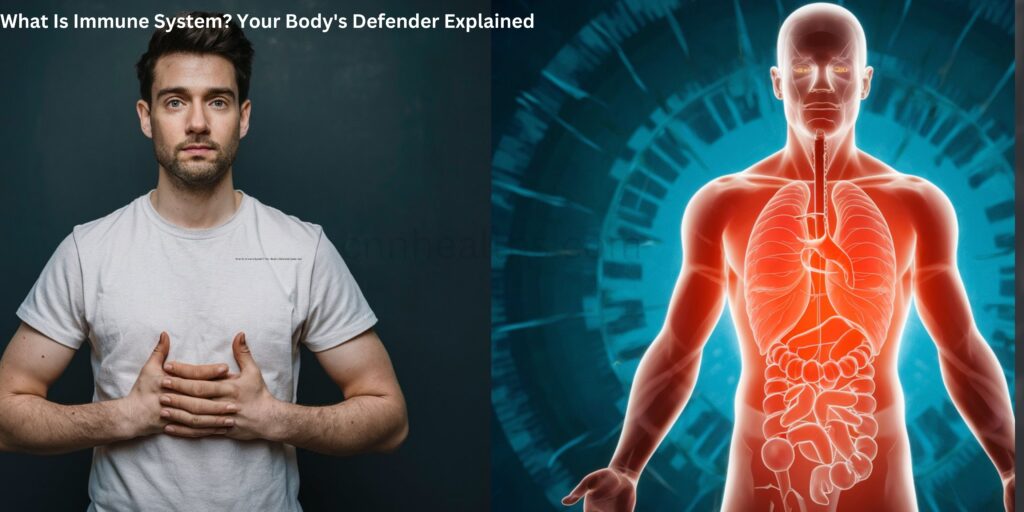Intro
This article is totally related to “What Is Immune System? Your Body’s Defender Explained.” Have you ever wondered what is immune system and how it works to protect your body from harmful invaders? The immune system is a complex network of cells, tissues, and organs that work together to defend your body against bacteria, viruses, parasites, and other pathogens. In this blog post, we will explore the basics of the immune system, how it detects and action pathogens, the difference between innate and adaptive immunity, the role of vaccines in immune system function, common immune system disorders and diseases, as well as nutrition and lifestyle choices that can boost immune health. We will also take a look at the future of immunology, including emerging research and innovations in the field.

The Basics of the Immune System
This article is totally related to “What Is Immune System? Your Body’s Defender Explained.”Diving into the core of our health defense mechanism, the immune system is essentially the superhero of our body, tirelessly working behind the scenes to shield us from the myriad of microscopic villains that threaten our well-being. This system is an intricate alliance of soldiers – cells, tissues, and organs – that collaborate in a sophisticated manner to ward off unwanted intruders like bacteria, viruses, and parasites.
Imagine your immune system as a highly skilled detective and champion, combo. It’s constantly on the lookout for potential threats, distinguishing between what belongs to the body and what doesn’t. This system includes frontline defenders such as the skin and mucous membranes, which act as sturdy walls keeping out a majority of invaders. However, should these barriers be breached, the immune system has a more specialized force ready to engage – the white blood cells.
These units do operations of in 2 main small groups of the innate and the adjusting free from danger systems .The innate system acts swiftly, offering a broad-stroke response to challenges, not wasting time in identifying the specific nature of the threat. On the flip side, the adaptive system takes a more calculated approach, tailoring its charge to the specific type of invader, remembering it for quicker response in future encounters.
This dual approach allows the immune system to effectively counteract a vast array of pathogens, ensuring our body remains a fortress against diseases. The fascinating dance between these two arms of the immune system is what keeps us healthy in the face of constant microbial onslaught. As we navigate through the wonders of this defense system, it’s clear that the immune system is not just a protector but also a marvel of biological engineering, showcasing the brilliance of nature’s design in safeguarding our health.
How the Immune System Detects and Action Pathogens
Embarking on a microscopic journey, imagine a pathogen sneaking its way into your body, thinking it’s found an easy target. Little does it know, your immune system is already springing into action, mobilizing a sophisticated and dynamic defense mechanism designed to seek and destroy these unwanted guests. The heroes of this story? White blood cells, the body’s very own elite force, comprising various specialists equipped with the skills to identify, engage, and eliminate invaders.
Among these specialists are the macrophages having a family relation to the immune system’s first. These cells patrol your body’s highways and byways, engulfing pathogens in a process reminiscent of Pac-Man. Then, there are the neutrophils, which, much like fire action dousing flames, release chemicals that help destroy the invaders. But the intrigue doesn’t end there. The lymphocytes, including T cells and B cells, play a more nuanced role. These cells are the strategists, tailoring the body’s defense to the specific type of intruder, remembering their tactics for a swifter defeat in future encounters.
The process of detection and defense is an elegant dance of signals and actions. Pathogens, carrying foreign markers called antigens, are identified as threats, prompting an alarm within the immune system. This triggers a cascade of responses, from the release of antibodies by B cells that tag pathogens for destruction, to the T cells’ orchestration of an charge against compromised cells. It’s a hostile, yes, but one that’s carried out with the precision and coordination of a well-rehearsed ballet, ensuring that peace and health are maintained within the realm of your body.
As pathogens evolve, so too does our understanding of the immune system’s tactics in this ongoing game of chess. This continuous adaptation and learning underline the brilliance and resilience of our body’s defense system, a testament to the wonders of the biological world and our enduring quest for health and wellbeing.
Innate vs. Adaptive Immunity: Understanding the Two Arms
Picture the immune system as a highly efficient, well-organized army, prepared at a moment’s notice to defend your body’s health. This army is divided into two elite forces: the innate and the adaptive immunity, each with its unique strategy and set of skills designed to combat invaders.
The innate immune system is like the rapid response team. It’s always ready, equipped with nonspecific defense mechanisms that spring into action immediately upon detecting an invader.This covers walls to keep others out such as your skin, which acts like the military building made strong against charge walls, and is (became) expert with special knowledge units like macrophages and neutrophils that group of men going round on watch the body, looking for trouble. . These components of the innate system don’t need to recognize the specific details of the enemy; their job is to block or charge anything that’s not supposed to be there, offering a blanket level of protection against a broad spectrum of threats.
On the other side, we have the adaptive immune system, which is more like the special ops team. This force is highly specialized and requires time to analyze the enemy before launching a targeted charge. T and B lymphocytes are the key players here, acting with precision to remember and charge specific pathogens. Thanks to this memory, the adaptive immunity can provide a faster and more efficient response upon reencountering a previously defeated pathogen, offering long-lasting defense based on past strugling.
Together, these two arms of the immune system work in concert to provide a comprehensive defense strategy. While the innate arm provides immediate, generalized protection, the adaptive arm builds a tailored, enduring defense, ensuring your body is equipped to handle the vast array of health threats it encounters. Through their combined efforts, these two arms of immunity keep you healthy, adapting, and responding to the ever-changing landscape of pathogens.
The Role of Vaccines in Immune System Function
Imagine stepping into a virtual reality game where your body’s immune system gets a preview and practice session against invaders without facing the real danger. That’s precisely the genius behind vaccines. Acting as educators, vaccines introduce a safe imitation of a pathogen, like a deactivated virus or a tiny piece of it, into the body. This mock drill doesn’t cause the disease but does set off the immune system’s alarm bells.
When this happens, the immune system jumps into action as if it were a real threat, learning to recognize and remember the invader. It starts producing antibodies, the body’s own superhero team, designed to target that specific pathogen. But here’s the clever part: the immune system also creates memory cells. These cells linger long after the vaccine has done its job, ready to spring into action much faster if the actual pathogen ever dares to make an appearance. It’s like having an instant recall of the villain’s weakness in a video game, enabling a quicker and more effective response to defeat it.
This proactive training session offered by vaccines has been a game-changer in the strugle against infectious diseases. Through this ingenious method, we’ve managed to keep numerous illnesses at bay, turning what were once formidable opponents into manageable threats. Vaccines not only protect individuals who receive them but also create a shield around the community by reducing the spread of diseases. It’s a brilliant showcase of how understanding and harnessing the immune system’s capabilities can lead to powerful tools in our ongoing quest for health and wellness.
Common Immune System Disorders and Diseases
In the vast and intricate world of our immune system, most of the time, it operates like a well-oiled machine, defending us against countless threats. However, there are moments when this complex system experiences a glitch, leading to conditions that can challenge our health in unexpected ways. Autoimmune disorders are a prime example of this glitch, where the body’s defense forces mistakenly identify its own tissues as foreign invaders, launching charge that can cause inflammation and damage. Conditions such as rheumatoid arthritis, lupus, and type 1 diabetes emerge from such internal misunderstandings, leading to a wide range of symptoms and challenges.
Another area where our immune system can become overly enthusiastic is in the realm of allergies. Here, substances that are generally harmless, such as pollen, pet dander, or certain foods, are treated as significant threats. This overreaction can trigger responses ranging from mild irritation, like sneezing and itching, to more severe, potentially life-threatening reactions such as anaphylaxis.
Understanding these disorders is more than an academic pursuit; it’s a crucial step toward developing effective treatments and improving the lives of those affected. Each discovery peels back another layer of the complex interactions that govern our immune responses, offering hope for new therapies that can calm an overactive immune system or correct its misdirected charge. The journey through the immune system’s challenges is a testament to the resilience and complexity of the human body, inviting us to explore, understand, and ultimately find pathways to better health amidst these internal strugle.
Nutrition and Lifestyle Choices That Boost Immune Health
Embarking on a quest for optimal immune health takes more than just a passing nod to the latest health trends; it involves a conscious, daily commitment to nurturing our body’s natural defenses. Envision your immune system as a garden that flourishes with the right balance of sunlight, water, and soil nutrients. Similarly, our immune system thrives on a diet rich in colorful fruits and vegetables, brimming with antioxidants that act as the body’s own personal shield against free radicals and infections. These foods are the unsung heroes, packed with vitamins C and E, beta-carotene, and minerals like zinc and selenium, which are essential for maintaining an alert and responsive immune system.
Beyond the plate, the journey to bolstering your immune health extends into the lifestyle choices we make. Regular physical activity isn’t just about keeping fit; it’s a beacon for immune health, enhancing circulation and contributing to a well-coordinated system ready to fend off invaders. The tranquil realms of adequate sleep and effective stress management are akin to the secret sanctuaries of immune resilience, providing restoration and balance to our bodies’ intricate systems.
Venturing further into the landscape of immune health, let’s not overlook the impact of moderation. The siren songs of searing and excessive heavy drinking beckon with false promises of relaxation and social ease but ultimately erode the fortifications of our immune system. Steering clear of these habits is akin to choosing the path of vitality and vigor, ensuring our body’s defenses remain vigilant and robust.
As we navigate through life’s daily challenges, embracing these nutritional and lifestyle choices is not merely about avoiding illness; it’s a testament to the reverence we hold for our body’s remarkable ability to protect, heal, and thrive.
The Future of Immunology: Emerging Research and Innovations
As we venture into the frontier of immunology, the horizon is aglow with groundbreaking advancements and possibilities..Portray the immune system as a constantly evolving puzzle, with scientists on the verge of adding crucial pieces that could reshape our approach to health and disease. Cutting-edge technologies,such as CRISPR gene editing, are on the cusp of allowing us to rewrite the very code of life, offering hope for eradicating genetic diseases and enhancing our innate defense mechanisms. Similarly, personalized immunotherapy is tailoring treatments to the individual’s unique immune landscape, marking a shift towards more effective and targeted approaches in strugling cancer and chronic illnesses.
In this dynamic field, the exploration of the microbiome reveals its profound influence on our immune system, suggesting that the future of immunology may also lie in harnessing the power of the billions of microbes that call our bodies home. With each discovery, we inch closer to unraveling the complexities of immune responses, opening doors to innovative therapies that promise to transform lives. The journey ahead in immunology is not just about combating diseases; it’s about unlocking the full potential of our body’s most formidable protector.

